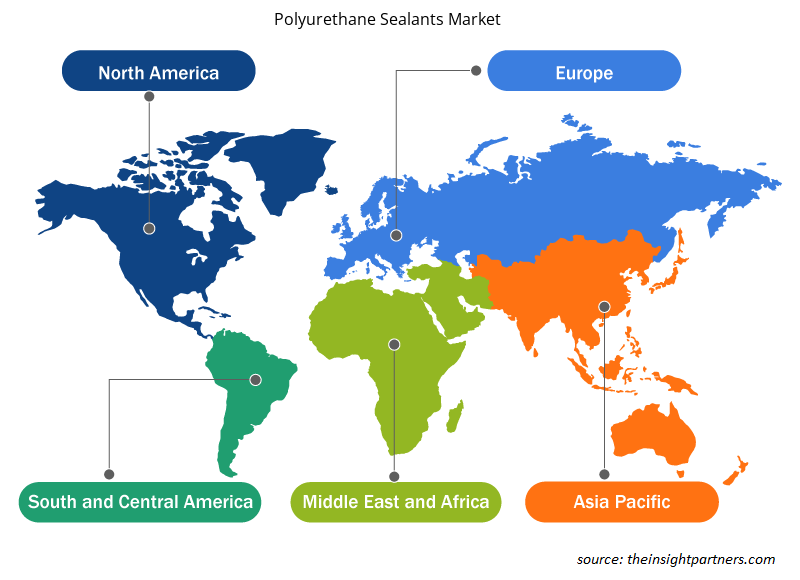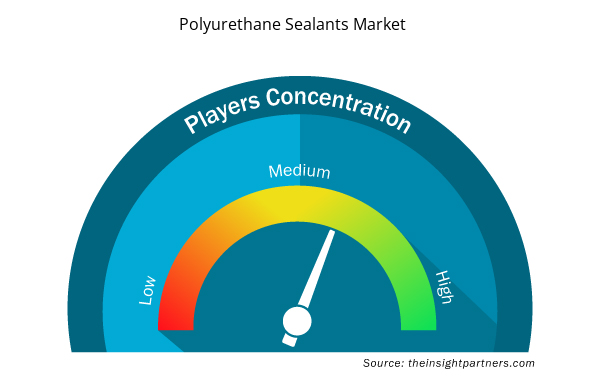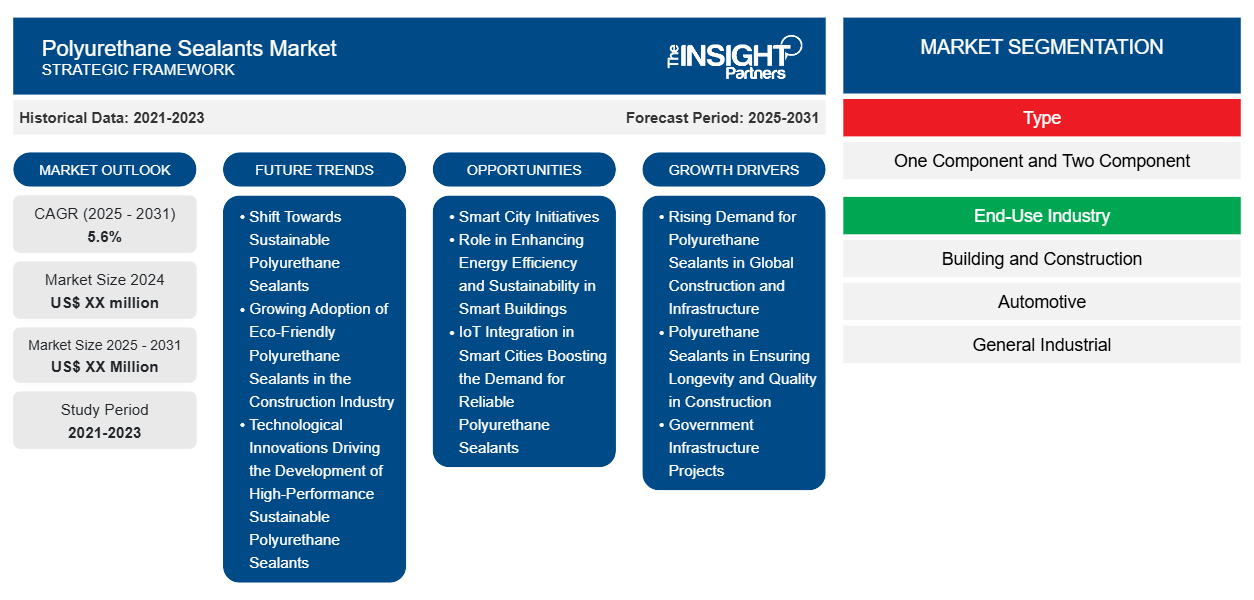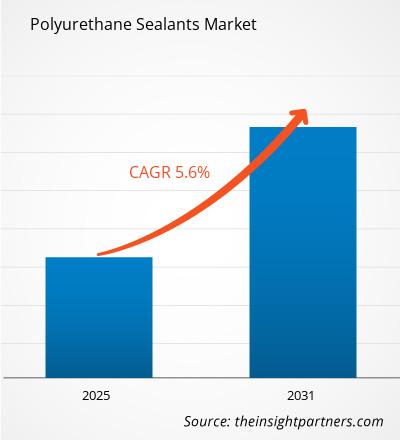Le marché des produits d'étanchéité en polyuréthane devrait enregistrer un TCAC de 5,6 % de 2024 à 2031, avec une taille de marché passant de XX millions USD en 2024 à XX millions USD d'ici 2031.CAGR of 5.6% from 2024 to 2031, with a market size expanding from US$ XX million in 2024 to US$ XX Million by 2031.
Le rapport est segmenté par type (un composant et deux composants). Le rapport est également segmenté en fonction de l'industrie d'utilisation finale (bâtiment et construction, automobile, industrie générale, marine et autres). Le rapport couvre 5 régions : Amérique du Nord, Europe, Asie-Pacifique, Moyen-Orient et Afrique, Amérique du Sud et centrale et pays clés de chaque région. L'analyse globale est ensuite décomposée au niveau régional et par principaux pays. Le rapport offre la valeur en USD pour l'analyse et les segments ci-dessus.
Objectif du rapport
Le rapport sur le marché des mastics en polyuréthane de The Insight Partners vise à décrire le paysage actuel et la croissance future, les principaux facteurs moteurs, les défis et les opportunités. Cela fournira des informations à diverses parties prenantes commerciales, telles que :
- Fournisseurs/fabricants de technologie : pour comprendre l’évolution de la dynamique du marché et connaître les opportunités de croissance potentielles, leur permettant de prendre des décisions stratégiques éclairées.
- Investisseurs : Effectuer une analyse complète des tendances concernant le taux de croissance du marché, les projections financières du marché et les opportunités qui existent tout au long de la chaîne de valeur.
- Organismes de réglementation : Réglementer les politiques et surveiller les activités du marché dans le but de minimiser les abus, de préserver la confiance des investisseurs et de maintenir l’intégrité et la stabilité du marché.
Segmentation du marché des mastics polyuréthane
Taper
- Un composant et deux composants
Secteur d'utilisation finale
- Bâtiment et construction
- Automobile
- Industrie générale
- Marin
- Autres
Personnalisez ce rapport en fonction de vos besoins
Vous bénéficierez d'une personnalisation gratuite de n'importe quel rapport, y compris de certaines parties de ce rapport, d'une analyse au niveau des pays, d'un pack de données Excel, ainsi que de superbes offres et réductions pour les start-ups et les universités.
- Obtenez les principales tendances clés du marché de ce rapport.Cet échantillon GRATUIT comprendra une analyse de données, allant des tendances du marché aux estimations et prévisions.
Facteurs de croissance du marché des mastics polyuréthane
- Demande croissante de mastics polyuréthane dans le secteur de la construction et des infrastructures à l'échelle mondiale : l'un des principaux moteurs du marché des mastics polyuréthane est le développement croissant de la construction et des infrastructures à travers le monde. Avec le taux d'urbanisation et de croissance démographique toujours croissant, la demande de bâtiments résidentiels, commerciaux et industriels augmente. Les mastics polyuréthanes constituent un élément essentiel de ces projets car ils présentent une adhérence, une flexibilité et une durabilité supérieures qui les rendent adaptés au scellement des joints et des interstices.
- Les mastics en polyuréthane garantissent la longévité et la qualité dans la construction : Les mastics en polyuréthane ont également gagné en popularité dans la construction, par exemple, car ils garantissent des performances de qualité dans diverses conditions environnementales. Une protection durable contre l'humidité, l'air et l'infiltration de poussière est essentielle pour maintenir l'intégrité des structures, et une telle demande de qualité et de longévité dans les travaux de construction est susceptible de voir la recherche de mastics hautes performances tels que le polyuréthane augmenter considérablement.
- Projets d'infrastructures gouvernementales : De plus, les projets d'infrastructures initiés par le gouvernement créent une demande pour ce matériau. La plupart des pays modernisent leurs infrastructures existantes et construisent de nouvelles installations, créant ainsi un marché solide pour les matériaux de construction de toutes sortes, y compris les mastics polyuréthanes. Les fabricants ont ainsi une immense opportunité d'introduire de nouveaux produits sur le marché pour s'adapter aux conditions changeantes.
Tendances futures du marché des mastics polyuréthane
- L'évolution vers des mastics polyuréthane durables : La préférence des consommateurs pour les mastics polyuréthane s'est orientée vers des solutions de mastic principalement durables. Ces entreprises se concentrent sur l'amélioration de produits respectueux de l'environnement qui limitent leurs dommages à l'environnement. Elles sont poussées par des facteurs réglementaires et par la demande des consommateurs en termes de matériaux de construction plus durables.
- Adoption croissante de mastics polyuréthanes écologiques dans le secteur de la construction : à cet égard, le secteur de la construction en particulier adopte des pratiques durables, ce qui se traduit par une tendance croissante à opter pour des mastics à base de sources renouvelables et à faible teneur en COV. Les mastics polyuréthanes qui répondent à ces exigences contribuent à une meilleure qualité de l'air intérieur et sont mieux conformes aux certifications de construction écologique généralement adoptées ; par conséquent, ils sont plus attrayants pour les constructeurs et les architectes soucieux de la durabilité.
- Les innovations technologiques favorisent le développement de mastics polyuréthane durables et performants : les avancées technologiques permettent désormais le développement de mastics polyuréthane durables et performants qui ne compromettent pas la qualité. Ces innovations permettent aux producteurs de fabriquer des produits qui offrent une excellente adhérence, flexibilité et durabilité tout en présentant un profil environnemental très doux. À l'avenir, la tendance vers la durabilité ne cessera de croître, ce qui entraînera une augmentation de la demande de mastics polyuréthane respectueux de l'environnement, présentant ainsi un énorme potentiel d'expansion sur le marché.
Opportunités de marché pour les mastics en polyuréthane
- Initiatives pour les villes intelligentes : les initiatives pour les villes intelligentes représentent une opportunité importante pour le marché des mastics polyuréthane. L'adoption croissante de technologies intelligentes par les zones urbaines est susceptible d'améliorer les infrastructures et le mode de vie. Cette demande devrait encore accroître la demande de matériaux de construction avancés tels que les mastics polyuréthane, qui constituent des exigences cruciales pour des bâtiments et des infrastructures intelligents durables et efficaces.
- Rôle dans l'amélioration de l'efficacité énergétique et de la durabilité dans les bâtiments intelligents : les matériaux destinés aux villes intelligentes doivent démontrer une résistance à de nombreuses pressions environnementales tout en offrant des propriétés d'étanchéité exceptionnelles. Les mastics polyuréthanes offrent une excellente application dans les bâtiments intelligents, qui impliquent l'étanchéité des joints et des interstices dans les zones de façade, de fenêtres et de toit. Des caractéristiques d'adhérence et de flexibilité supérieures garantissent une efficacité énergétique et une durabilité compatibles avec les objectifs des développements des villes intelligentes.
- L'intégration de l'IoT dans les villes intelligentes stimule la demande de mastics polyuréthane fiables : De plus, l'intégration des technologies IoT dans les projets de construction nécessite des solutions d'étanchéité fiables qui peuvent accueillir l'installation de capteurs et d'autres appareils intelligents. Les villes offrant des infrastructures qui incluent des technologies intelligentes, la demande de mastics polyuréthane haute performance est susceptible d'augmenter. Cette tendance donnera aux fabricants l'occasion d'innover et de répondre aux besoins changeants du secteur de la construction en matière d'initiatives de villes intelligentes.
Aperçu régional du marché des mastics polyuréthanes
Les tendances régionales et les facteurs influençant le marché des mastics en polyuréthane tout au long de la période de prévision ont été expliqués en détail par les analystes d’Insight Partners. Cette section traite également des segments et de la géographie du marché des mastics en polyuréthane en Amérique du Nord, en Europe, en Asie-Pacifique, au Moyen-Orient et en Afrique, ainsi qu’en Amérique du Sud et en Amérique centrale.

- Obtenez les données régionales spécifiques au marché des mastics en polyuréthane
Portée du rapport sur le marché des mastics en polyuréthane
| Attribut de rapport | Détails |
|---|---|
| Taille du marché en 2024 | XX millions de dollars américains |
| Taille du marché d'ici 2031 | XX millions de dollars américains |
| Taux de croissance annuel composé mondial (2025-2031) | 5,6% |
| Données historiques | 2021-2023 |
| Période de prévision | 2025-2031 |
| Segments couverts | Par type
|
| Régions et pays couverts | Amérique du Nord
|
| Leaders du marché et profils d'entreprises clés |
|
Densité des acteurs du marché des mastics polyuréthanes : comprendre son impact sur la dynamique commerciale
Le marché des mastics en polyuréthane connaît une croissance rapide, tirée par la demande croissante des utilisateurs finaux en raison de facteurs tels que l'évolution des préférences des consommateurs, les avancées technologiques et une plus grande sensibilisation aux avantages du produit. À mesure que la demande augmente, les entreprises élargissent leurs offres, innovent pour répondre aux besoins des consommateurs et capitalisent sur les tendances émergentes, ce qui alimente davantage la croissance du marché.
La densité des acteurs du marché fait référence à la répartition des entreprises ou des sociétés opérant sur un marché ou un secteur particulier. Elle indique le nombre de concurrents (acteurs du marché) présents sur un marché donné par rapport à sa taille ou à sa valeur marchande totale.
Les principales entreprises opérant sur le marché des mastics polyuréthanes sont :
- Arkema SA
- BASF
- Produits d'étanchéité Hodgson
- Kommerling Chemische Fabrik Kg
- Mapei S.p.A.
Avis de non-responsabilité : les sociétés répertoriées ci-dessus ne sont pas classées dans un ordre particulier.

- Obtenez un aperçu des principaux acteurs du marché des mastics polyuréthanes
Principaux arguments de vente
- Couverture complète : Le rapport couvre de manière exhaustive l’analyse des produits, des services, des types et des utilisateurs finaux du marché des produits d’étanchéité en polyuréthane, offrant un paysage holistique.
- Analyse d’experts : Le rapport est compilé sur la base d’une compréhension approfondie des experts et analystes du secteur.
- Informations à jour : Le rapport garantit la pertinence commerciale en raison de sa couverture des informations récentes et des tendances des données.
- Options de personnalisation : ce rapport peut être personnalisé pour répondre aux exigences spécifiques du client et s'adapter parfaitement aux stratégies commerciales.
Le rapport de recherche sur le marché des mastics en polyuréthane peut donc aider à ouvrir la voie au décodage et à la compréhension du scénario de l’industrie et des perspectives de croissance. Bien qu’il puisse y avoir quelques préoccupations valables, les avantages globaux de ce rapport ont tendance à l’emporter sur les inconvénients.
- Analyse historique (2 ans), année de base, prévision (7 ans) avec TCAC
- Analyse PEST et SWO
- Taille du marché Valeur / Volume - Mondial, Régional, Pays
- Industrie et paysage concurrentiel
- Ensemble de données Excel


- Visualization and 3D Rendering Software Market
- Small Satellite Market
- Vessel Monitoring System Market
- Authentication and Brand Protection Market
- Skin Tightening Market
- Real-Time Location Systems Market
- Architecture Software Market
- Automotive Fabric Market
- Flexible Garden Hoses Market
- Toothpaste Market

Report Coverage
Revenue forecast, Company Analysis, Industry landscape, Growth factors, and Trends

Segment Covered
This text is related
to segments covered.

Regional Scope
North America, Europe, Asia Pacific, Middle East & Africa, South & Central America

Country Scope
This text is related
to country scope.
Questions fréquemment posées
Based on geography, Asia Pacific is expected to register the fastest CAGR from 2023 to 2031.
Increasing focus on sustainable sealant solutions is one of the key trends for the market growth.
Arkema S.A., BASF, Hodgson Sealants, Kommerling Chemische Fabrik Kg, Mapei S.p.A., PCI Augsburg GmbH, Selena Co. SA, Sika AG, Splendor Industry Company Limited, and Sunstar Engineering Inc. are among the leading players operating in the polyurethane sealants market.
The report can be delivered in PDF/Word format, we can also share excel data sheet based on request.
Growing construction and infrastructure development is driving the market growth
The Polyurethane Sealants Market is estimated to witness a CAGR of 5.6% from 2023 to 2031
Trends and growth analysis reports related to Chemicals and Materials : READ MORE..
1. Arkema S. A.
2. BASF
3. Hodgson Sealants
4. Kommerling Chemische Fabrik Kg
5. Mapei S. p. A.
6. PCI Augsburg GmbH
7. Selena Co. , SA
8. Sika AG
9. Splendor Industry Company Limited
10. Sunstar Engineering,Inc.
The Insight Partners performs research in 4 major stages: Data Collection & Secondary Research, Primary Research, Data Analysis and Data Triangulation & Final Review.
- Data Collection and Secondary Research:
As a market research and consulting firm operating from a decade, we have published and advised several client across the globe. First step for any study will start with an assessment of currently available data and insights from existing reports. Further, historical and current market information is collected from Investor Presentations, Annual Reports, SEC Filings, etc., and other information related to company’s performance and market positioning are gathered from Paid Databases (Factiva, Hoovers, and Reuters) and various other publications available in public domain.
Several associations trade associates, technical forums, institutes, societies and organization are accessed to gain technical as well as market related insights through their publications such as research papers, blogs and press releases related to the studies are referred to get cues about the market. Further, white papers, journals, magazines, and other news articles published in last 3 years are scrutinized and analyzed to understand the current market trends.
- Primary Research:
The primarily interview analysis comprise of data obtained from industry participants interview and answers to survey questions gathered by in-house primary team.
For primary research, interviews are conducted with industry experts/CEOs/Marketing Managers/VPs/Subject Matter Experts from both demand and supply side to get a 360-degree view of the market. The primary team conducts several interviews based on the complexity of the markets to understand the various market trends and dynamics which makes research more credible and precise.
A typical research interview fulfils the following functions:
- Provides first-hand information on the market size, market trends, growth trends, competitive landscape, and outlook
- Validates and strengthens in-house secondary research findings
- Develops the analysis team’s expertise and market understanding
Primary research involves email interactions and telephone interviews for each market, category, segment, and sub-segment across geographies. The participants who typically take part in such a process include, but are not limited to:
- Industry participants: VPs, business development managers, market intelligence managers and national sales managers
- Outside experts: Valuation experts, research analysts and key opinion leaders specializing in the electronics and semiconductor industry.
Below is the breakup of our primary respondents by company, designation, and region:

Once we receive the confirmation from primary research sources or primary respondents, we finalize the base year market estimation and forecast the data as per the macroeconomic and microeconomic factors assessed during data collection.
- Data Analysis:
Once data is validated through both secondary as well as primary respondents, we finalize the market estimations by hypothesis formulation and factor analysis at regional and country level.
- Macro-Economic Factor Analysis:
We analyse macroeconomic indicators such the gross domestic product (GDP), increase in the demand for goods and services across industries, technological advancement, regional economic growth, governmental policies, the influence of COVID-19, PEST analysis, and other aspects. This analysis aids in setting benchmarks for various nations/regions and approximating market splits. Additionally, the general trend of the aforementioned components aid in determining the market's development possibilities.
- Country Level Data:
Various factors that are especially aligned to the country are taken into account to determine the market size for a certain area and country, including the presence of vendors, such as headquarters and offices, the country's GDP, demand patterns, and industry growth. To comprehend the market dynamics for the nation, a number of growth variables, inhibitors, application areas, and current market trends are researched. The aforementioned elements aid in determining the country's overall market's growth potential.
- Company Profile:
The “Table of Contents” is formulated by listing and analyzing more than 25 - 30 companies operating in the market ecosystem across geographies. However, we profile only 10 companies as a standard practice in our syndicate reports. These 10 companies comprise leading, emerging, and regional players. Nonetheless, our analysis is not restricted to the 10 listed companies, we also analyze other companies present in the market to develop a holistic view and understand the prevailing trends. The “Company Profiles” section in the report covers key facts, business description, products & services, financial information, SWOT analysis, and key developments. The financial information presented is extracted from the annual reports and official documents of the publicly listed companies. Upon collecting the information for the sections of respective companies, we verify them via various primary sources and then compile the data in respective company profiles. The company level information helps us in deriving the base number as well as in forecasting the market size.
- Developing Base Number:
Aggregation of sales statistics (2020-2022) and macro-economic factor, and other secondary and primary research insights are utilized to arrive at base number and related market shares for 2022. The data gaps are identified in this step and relevant market data is analyzed, collected from paid primary interviews or databases. On finalizing the base year market size, forecasts are developed on the basis of macro-economic, industry and market growth factors and company level analysis.
- Data Triangulation and Final Review:
The market findings and base year market size calculations are validated from supply as well as demand side. Demand side validations are based on macro-economic factor analysis and benchmarks for respective regions and countries. In case of supply side validations, revenues of major companies are estimated (in case not available) based on industry benchmark, approximate number of employees, product portfolio, and primary interviews revenues are gathered. Further revenue from target product/service segment is assessed to avoid overshooting of market statistics. In case of heavy deviations between supply and demand side values, all thes steps are repeated to achieve synchronization.
We follow an iterative model, wherein we share our research findings with Subject Matter Experts (SME’s) and Key Opinion Leaders (KOLs) until consensus view of the market is not formulated – this model negates any drastic deviation in the opinions of experts. Only validated and universally acceptable research findings are quoted in our reports.
We have important check points that we use to validate our research findings – which we call – data triangulation, where we validate the information, we generate from secondary sources with primary interviews and then we re-validate with our internal data bases and Subject matter experts. This comprehensive model enables us to deliver high quality, reliable data in shortest possible time.


 Obtenez un échantillon gratuit pour ce rapport
Obtenez un échantillon gratuit pour ce rapport